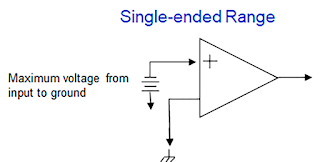
Article

Probe Safety Demystified: Dynamic Range and Voltage Swing
One of the most basic things to know when using any probe is “what is the maximum voltage the device can safely measure?” The answer isn’t as straightforward as you might imagine, it requires understanding several key probe specifications as well as the nature of your signal.
Single-ended Range
Everyone is pretty familiar with single-ended range: that's the maximum safe voltage input to ground, shown in Figure 1. Ground is directly tied to oscilloscope ground, which is tied to building ground. Therefore, when measuring voltage within this range using a single-ended probe, the ground connection cannot be a floating voltage, or you could damage the probe, the DUT, the oscilloscope...maybe yourself, as well. Single-ended voltage must be a grounded voltage on your board or something that could be tied to ground.
Dynamic Range and Maximum Non-destruct Input Voltage

Figure 2. Differential mode range is measured between inputs.
Differential range (DMR) is the maximum instantaneous voltage that can safely appear between the two inputs of a differential amplifier, shown in Figure 2. You don't need a ground or a board reference connection. It's very easy to do, but pay attention to the common mode range (CMR) of the probe to make sure you don't exceed it, either. Each one of those plus and minus inputs has a maximum input voltage compared to ground that it's rated for, as well, as shown in Figure 3. As we discussed in an earlier post on dynamic ranges, the common-mode range is not always symmetrical with respect to ground, which means that in some amplifiers, the common-mode range in the positive direction from ground will be different from that in the negative direction.

Figure 3. Common mode range is measured either input to ground.
In the high-voltage probe world, we know that CMR (and the source impedance of the load) dictates the Measurement Category (CAT) rating, and it's typically at 1000 V but could be higher or lower. CMR is not normally directly measured by the probe (as is DMR), but is achieved through the probe’s topology. It’s important to be sure your probe has a suitable common mode range for the circuit you're going to be connected to.
Any conventional high-attenuation, high-voltage differential probe commonly has a specification that indicates the maximum common mode voltage at which the probe can be used to ensure operator safety and equipment safety. This is often referred to as the maximum non-destruct input voltage. It does not mean that the probe will give you a good measurement result at that voltage; it just means you won't be killed, your equipment won't be damaged, and your DUT won't be destroyed.
Voltage Swing
Related Topics:
No Related Topics at this time.